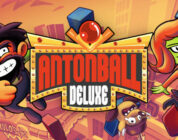I had the pleasure of getting a chance to play Super Rude Bear Resurrection while walking through PAX East’s Indie MegaBooth. It was after this that I decided to keep this game on my radar, because I was so impressed by it’s level design. It was funny to see other players come up and die many times, yet they were so determined to get through it. After finally getting my chance to play the whole game, I was pleasantly surprised by how much different content this game had. From the upbeat music to some colorful and diverse environments, this is a title that’s worth getting for anyone who loves a challenging platformer.
Super Rude Bear has the player take control of The Rude Bear, a gangsta bear from London, who must defeat his mortal enemy, The Wizard. His journey will lead him through many different obstacles, which range from jungle environments, to a futuristic space station. On the way to his end, he’ll of course also enjoy some awesome and well paced music to guide him. The game has a soundtrack of about 73 songs; they all add to the aesthetic of the level being played at the time. The music has a nice range of genres and flavors, such as a 90s hip-hop sound, to some electronic/techno, sometimes even mixing all of them together. The soundtrack is emphasized heavily in Super Rude Bear making it a part of it’s identity.
Super Rude Bear Resurrection plays very similarly to the indie mega hit, Super Meat Boy. The game has players traversing through many different 2D platforming sections, which are naturally filled with death traps galore. While I did enjoy this game quite a bit, I will admit I yelled at my TV screen more than once. There were moments where I absolutely hated this game, where I wanted to rip out my hard drive and smash it to pieces so the game knows who’s boss. The beauty of it all is; that’s pretty much the point. Super Rude Bear does NOT hold the player’s hand whatsoever, but yet still wants them to succeed. I hesitate to call this game frustrating, because in game critique, that seems to be a negative word. However, the frustration is part of the whole experience. It seriously had me fuming and yelling combinations of curse words I didn’t even know existed. Did the game care though? Nope! It just continued to troll me and basically tell me the “git gud.”
I died more times in this game than I want to admit, but yet it never kept me away. I had deaths where I thought it was just super cheap, yet when I finally overcame the obstacle, I came to realize all my deaths were my fault, and not the game’s. Some video games want to reward players for patience, but Super Rude Bear isn’t one of them. Accuracy and speed are the two keys to success in Super Rude Bear Resurrection. Finally making that challenging jump, only to find myself stopping to catch my breath would end up sealing my fate. Constant precise jumps and movements are what really got me to the end of each level.
Super Rude Bear Resurrection adds a cool mechanic to the genre, in which dying in the game can either help or hinder the player. Whenever Rude Bear dies, (usually in gory but cartoony fashion I may add) his corpse will remain there for the remainder of the game, unless the player decides to melt them with their wizard. His corpse can be left on some spikes, which now lets the player use its own corpse as a cushion to avoid being impaled. While the mechanic may seem it is only there to help players, it actually can be the cause of death in the game’s later levels. Those corpses on the levels can actually get in the way in the more frantic sections, leading to the player’s demise.
In one world, there were these laser beams that can freeze Rude Bear if he’s not careful and instead of the corpse being set there, a block of ice is now floating in zero gravity. When in a pretty difficult section, I was constantly jumping and landing them perfectly, only to have those blocks of ice get in the way of my flow, leading me to miss a jump and starting over. What I find so fascinating about this mechanic is the risk/reward aspect of it all. It is possible to have it turned off in it’s higher difficulties, but I got too comfortable with it, even though the corpses got in the way.
The real star of Super Rude Bear Resurrection is its level design. The quality in the layout of every world is impeccable. No two worlds ever felt the same. If I could describe Super Rude Bear’s level design in one word, I would say, “variety.” This is a game that only has a few control inputs, which are pretty much just jumping and climbing. Yet, I never felt like I was doing the same thing over and over again thanks in part to each level feeling like a different experience. The game is at its most impressive when it has the level changing and moving. The level may end up tilting, making the player disoriented. In one boss fight, it was chasing me through a fast moving environment, leaving me jumping desperately to avoid traps. It was one of the most exhilarating experiences I’ve ever had in a platformer as I was constantly on the edge of my seat.
Super Rude Bear Resurrection played on my emotions throughout my entire playthrough. I yelled at my screen, either in excitement or agony. I had moments of intense and heart pounding encounters and other times my heart was racing as I was ready to throw my controller at my TV. This is what makes the game such a gem in the genre.
In my opinion, a tough video game is one that is never unfair. The player must never feel cheated, and in this case, I always felt like there was a correct way to overcome the challenge. The game may seem cruel to some players, but it’s just showing tough love. There’s no helping the player after many failed attempts, there’s only letting the player figure it out on their own. It’s a template for future indie developers for how to do level design right. There’s no doubt that love and care were put into this project, and I can’t wait to see what the developers do for the genre in the years to come.
Super Rude Bear Resurrection is out now for PS4 and Steam.
This review was done on the PS4 and a code was provided for.








